Anti-aircraft self-propelled Flakpanzer 38 (t) / Panzerkampfwagen 38 (t) für 2 cm FlaK 38 (Germany)
An interesting fact is that the new Flackpanzer project started only in the first half of 1943 - only a couple of years after the start of work on the Flakpanzer I and a few months after the loss of the last such self-propelled guns. According to some reports, this was due to the peculiarities of the situation at the front. German aviation still retained dominance in the air, and towed systems coped with the tasks of air defense. For this reason, the development of a new ZSU was considered desirable, but was not a priority. However, over time, the situation on the fronts has changed, which led to corresponding consequences.
In the first half of 1943, Böhmisch-Mährische Maschinenfabrik AG (BMM, now Českomoravská Kolben-Daněk), working in occupied Prague, began building a new self-propelled gun with anti-aircraft weapons. In order to accomplish the task, it was decided to widely use existing units. In particular, the base for the combat vehicle was to be the existing chassis, created on the basis of one of the previous developments. Armament also should not be developed from scratch: it was decided to use an existing automatic gun, similar to that used on the Flakpanzer I.
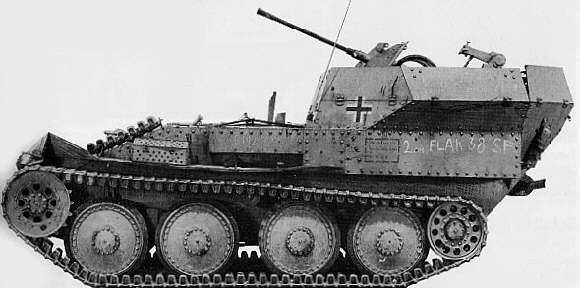
ZSU Flakpanzer 38 (t). Photo Panzer-archiv.de
The main element of the promising machine was to become the crawler chassis Selbstfahrlafette 38 (t) Ausf.M. This machine was a recycled light chassis. tank Pz.Kpfw.38 (t) with a redesigned and redesigned case. By the middle of the war, the original light tank no longer fully met the requirements for combat vehicles, but could still be used as the basis for auxiliary equipment. Based on this logic, Czech experts developed a modified chassis, which was planned to be used in the construction of various self-propelled artillery installations and other equipment.
In the new project it was planned to equip the base chassis with some additional units that would turn it into an anti-aircraft self-propelled unit. First of all, it was necessary to provide for the installation of anti-aircraft guns and protection for the calculation. In this case, it was possible to reduce the necessary reworking of the chassis, using the maximum number of finished units.
The Selbstfahrlafette 38 (t) Ausf.M multipurpose tracked chassis was a revised version of the Czechoslovak-developed Pz.Kpfw.38 (t) base tank. This machine retained most of the features of the original tank, but differed in some design features. The most important difference was in the layout of the case. It was assumed that such a chassis would be used in the construction of self-propelled artillery systems with aft location of the fighting compartment. In this regard, the engine compartment was moved from the stern of the hull into its middle part, which allowed freeing up the volume to accommodate the weapons and crew. The remaining units of the chassis were the most unified with the tank.
The Czechoslovak Light Tank had reservations with a thickness of up to 25 mm and could protect the crew from rifle weapons or small-caliber artillery systems. At the front of the Selbstfahrlafette 38 (t) Ausf.M chassis, there were transmission units that interact with driving wheels, as well as a driver's workplace. Directly behind them was the engine compartment with a petrol engine of power 150 hp, connected to the front transmission units using a propeller shaft.
Universal chassis retains the chassis base machine. On each side there were four support rollers, interlocked in pairs, with suspension based on leaf springs. Driving wheels were located in front, guides - behind. The chassis also included four supporting rollers (two per board), on which the front and middle parts of the upper branch of the track lay. Additional support for the rear half was not provided for: it had to lie on the rear support rollers and move to the steering wheel.
In the stern of the base chassis they proposed to establish a wheelhouse for the placement of weapons and weapons. Above the sides of the existing hull it was necessary to build on a structure of complex polygonal shape, consisting of 10-mm armor plates. The front sheets of such fellings were set at an angle to the vertical with an inclination back, and the sides and stern were wedge-shaped. All the cutting elements consisted of two plates connected by loops. Thus, if necessary, the crew could lower the upper frontal or side plates, increasing the angles of horizontal and vertical pickup.
Inside the aft superstructure, they placed a cabinet for mounting an automatic Flak 38 cannon of the 20 mm caliber, along with part of the original carriage. The gun retained the possibility of circular alignment horizontally. Vertical guidance could be from -5 ° to + 90 °, which made it possible to shoot both airborne and ground targets. The gun carriage, almost entirely borrowed from the original towed structure, had its own gunner’s workplace with manual guidance drives, a sight, and an armor shield to protect against firing from the front.
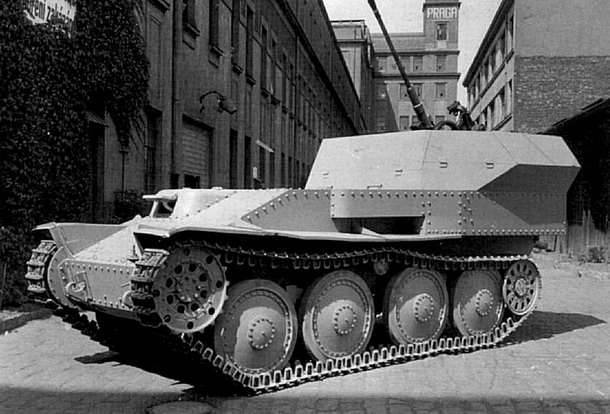
One of the serial machines. Photo of Panzernet.net
The FlaK 38 gun had a rifled 20 caliber mm 65 long caliber and was designed to attack enemy aircraft at low altitudes. The gun could fire at a rate of up to 450 shots per minute (practical rate of fire no more than 180-200 shots per minute) and hit targets at ranges up to 2,2 km. Ammunition could include several types of shells, including high-explosive fragmentation, armor-piercing, etc. The supply of ammunition was carried out from interchangeable stores with a capacity of 20 shells.
To manage the new self-propelled gun had a crew of four. In this case, the management of the chassis was trusted only to one driver, and for the maintenance of the gun, the calculation of their three people was to be responsible.
Due to the use of the chassis, based on the design of the light tank, the finished combat vehicle turned out to be relatively compact and did not have much weight. The combat weight was determined at the level of 9,8 T, the length was 4,6 m, the width - 2,13 m, the height - 2,25 m.
Designing self-propelled anti-aircraft self-propelled chassis base Selbstfahrlafette 38 (t) Ausf.M completed in the middle of the year 1943. Soon the first prototype was built, which was used during the tests. In general, the car showed itself well. The available engine allowed to accelerate on the highway to 40-42 km / h, and on rough terrain the maximum speed was reduced by half. Cruising, depending on the route, was 140-185 km. With power density more than 15 HP per ton self-propelled gun could overcome various obstacles. Due to the existing mobility of the machine had the ability to move and work in some combat formations with tanks and other armored vehicles, which is in service.
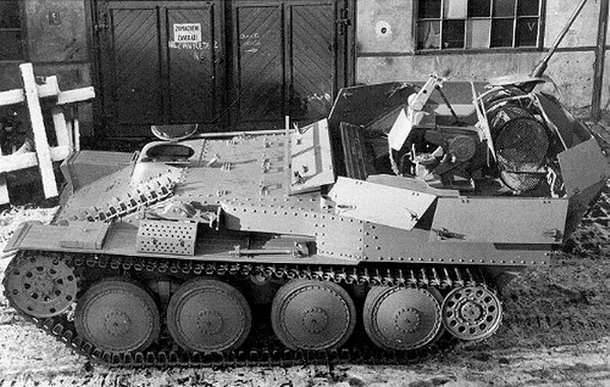
View from above. Photo of Panzernet.net
Used Flak 20 38-mm automatic gun has already been actively exploited anti-aircraft connections and managed to establish itself well. Nevertheless, due to the growth of aviation speeds, the real effectiveness of these weapons gradually fell. In the distant future, the arming of the ZSU with just one automatic gun no longer seemed sufficient. However, in the case of the new BMM project, this was considered acceptable. Probably, one of the main arguments in favor of the new self-propelled guns was the actual absence of alternatives and the urgent need for such means of defense against air attack.
In the autumn of 1943, the prototype anti-aircraft self-propelled gun passed all tests, after which the new equipment was put into service. According to the rules of the German nomenclature equipment of ground forces, ZSU difficult to obtain designation Panzerkampfwagen 38 (t) für 2 cm FlaK 38 ( «Chassis Panzerkampfwagen 38 (t) for 2-cm guns FlaK 38») and Sonderkraftfahrzeug 140 ( «special purpose vehicles, model 140 "). In addition, by analogy with the previous project, the designation Flakpanzer 38 (t) - “Anti-aircraft tank based on Pz.Kpfw.38 (t)” appeared. In different sources and documents on an equal footing, all these designations are used.
After the adoption of the new “Flakpantser”, BMM received an order for the serial construction of such equipment. Over the past few years, this company has been building Panzerkampfwagen 38 (t) tanks, and also relatively recently launched the production of the Selbstfahrlafette 38 (t) Ausf.M. universal chassis. Thus, no serious problems with the production of self-propelled guns were not expected. Nevertheless, for objective reasons, such as loading with other orders, the production rate of the new ZSU in practice left much to be desired. In accordance with the contract, in the next few months, the Prague factory was to build 150 new combat vehicles.
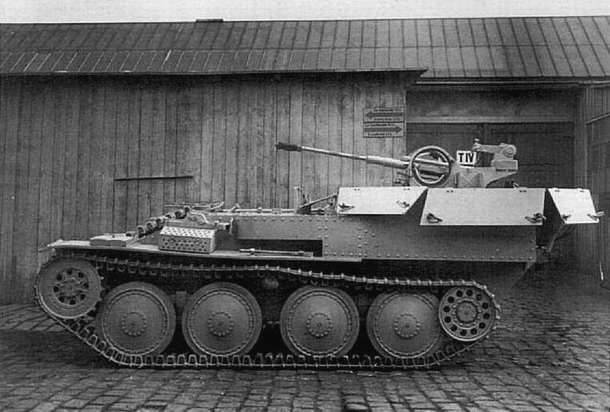
ZSU with folded sides. Photo of Panzernet.net
In the first few months of mass production, BMM was able to complete most of the order. Until the end of January, the 87 anti-aircraft self-propelled guns were built and transferred to the troops. After that, production continued, but its pace was constantly decreasing. The latest production Flakpanzer 38 (t), according to various sources, left the assembly hall in 1944. In total, the troops received a new type of 141 machine from the 150 ordered.
In September 1944, the ZSU Panzerkampfwagen 38 (t) für 2 cm FlaK 38 release was finally discontinued. The reason for this was the deployment of mass production of a new anti-tank self-propelled gun Jagdpanzer 38 (t), commissioned by BMM. The plant could not simultaneously build both cars in the required quantities, because of which self-propelled anti-aircraft installations were discontinued. In addition, by the autumn of 44, new samples of similar-purpose equipment with higher characteristics were put into service. After the deployment of their full-fledged production and re-equipment of the troops, the need for older equipment could completely disappear.
Serial combat vehicles of the new type were sent to serve in various units of the German army. Without losing time, ground forces threw self-propelled guns into battle with enemy aircraft. Having a weapon in the form of a single 20-mm automatic cannon, such a technique could withstand raids, but in some cases the firepower could be acceptable only with the simultaneous combat operation of several machines. At the same time, anti-aircraft armored vehicles could in some cases be used to defeat enemy ground forces, primarily light technology and infantry. In this case, a certain effectiveness of the fire was achieved, but there was a risk of firing back with fatal consequences. Despite all the problems, the operation of the Flakpanzer 38 (t) ZSU continued without a single alternative.
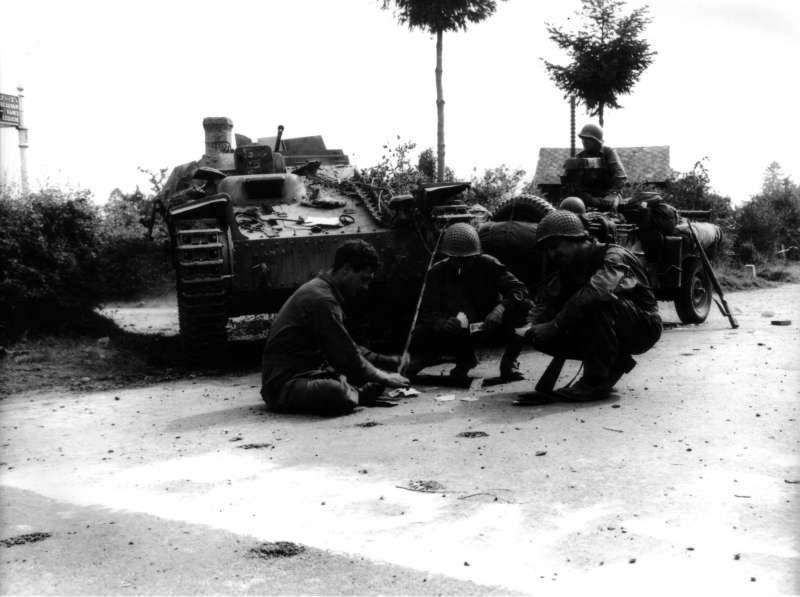
American soldiers rest after the battle. In the background, the broken Flakpanzer 38 ZSU (t). Normandy, 1944 g. Photo by Wikimedia Commons
According to reports, the service ZSU Panzerkampfwagen 38 (t) für 2 cm FlaK 38 started on the Eastern Front, and after the landing in Normandy, a number of such machines were redeployed to Western Europe. For obvious reasons, anti-aircraft weapons, including those on self-propelled chassis, were the priority target of Allied strike aircraft. Because of this, anti-aircraft units armed with Flakpantserami-38, constantly suffered losses. With the development of the offensive forces of the anti-Hitler coalition losses only intensified.
Some sources mention that by the beginning of the winter 1944, in the front-line parts of Germany, there were no more than a dozen capable Flakpanzer 38 (t) machines out of almost a hundred and fifty built. Shortly thereafter, the self-propelled guns that remained in the ranks shared the fate of the men of successful counterparts who died a little earlier. By the end of the war in Europe or a little earlier, all ZSU of this type were destroyed in battles under certain circumstances. Until our time, no such machine did not live.
The Flakpanzer 38 (t) / Panzerkampfwagen 38 (t) für 2 cm FlaK 38 / Sd.Kfz.140 project was a continuation of the German work on anti-aircraft self-propelled anti-aircraft artillery on the march and in positions. In comparison with the previous project Flakpanzer I, the new car turned out to be quite successful and had a lot of advantages. In addition, she managed to go into mass production in much larger quantities. However, 24, 141, and even 150 combat vehicles with automatic guns could not seriously affect the course of the fighting in Europe. For an effective confrontation of the enemy aviation of Germany, a much larger number of self-propelled self-propelled guns were needed, the construction of which, however, was almost impossible or extremely difficult. As a result, over time, the anti-Hitler coalition won air superiority and thus greatly brought victory.
On the materials of the sites:
http://achtungpanzer.com/
http://armor.kiev.ua/
http://panzer-archiv.de/
http://panzernet.net/
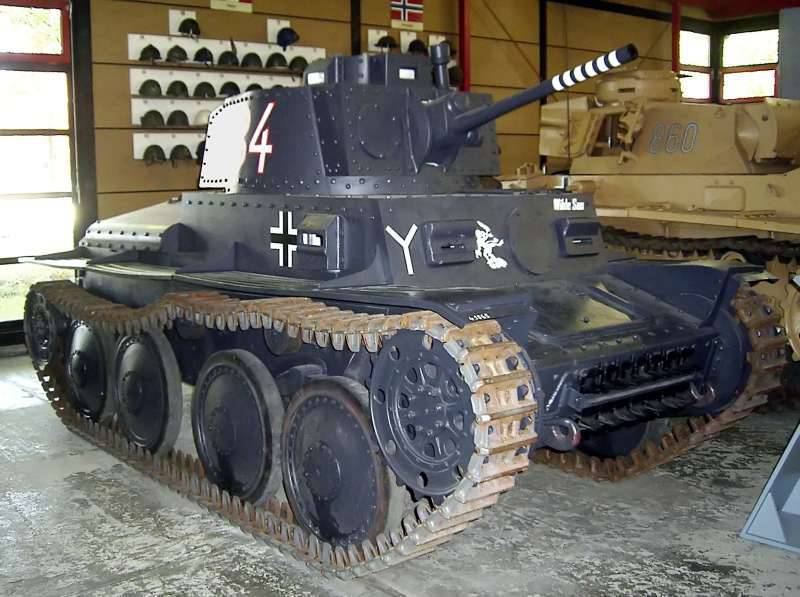
Information